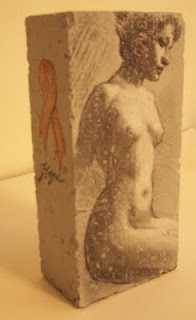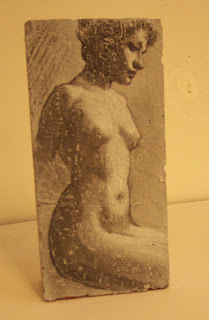Sunday, October 25th, 2009
2-5 p.m.
Mayerson JCC
8485 Ridge Road
Cincinnati, Ohio 45236
Here is my brick:

I decided to do this kind of last minute, as I was asked to do one after the deadline for submission. The weird thing about it all is that on the day I decided to do a brick I heard from someone that after a long absence. She had been having her own battle with breast cancer and is still struggling to get better. She is in good spirits but this really hit home the importance of finding a cure for this disease.
I started my brick the night before I was to turn it in, I did not have time to get too creative and used it as a chance to do a copy. I wanted the brick to show the beauty of the female form, and since I was reading through a book on figure drawing by Vanderpoel, I thought some of his work would be perfect. The only requirement is that the brick have some sort of artwork on it, and that it have the symbolic pink ribbon in it somewhere.
Before I get asked about why we are painting on bricks, the auction was started by a cancer victim that said when she got cancer it was like being hit with a ton of bricks, so since that time they decided to decorate those bricks and auction them off to raise awareness and money to fight for a cure.
So, go buy a brick.
Now, about my brick and the drawing I did on it. I primed the brick with gray alkyd house primer, and then did the drawing using charcoal and some chalk for the white. The brick surface was kind of interesting to draw on. It definitely was an nice texture to work with. While I am at it, I thought I would use this as an opportunity to talk about Vanderpoel and what I think makes his work special.
It is tough to find out much about Vanderpoel. There is not a lot of work available to see other than the drawings in his book.
|
|
|
|
|
|
|
|
|
|
|
|
|
|
|
|
|
|
|
| List Price: | $6.95 |
Vanderpoel was very respected teacher that taught for 30 years at Chicago's School of the Art Institute. When he died in 1911 he was so loved in the community that both a school and a street were named after him.
He taught a lot of students including George Bridgman. You maybe be more familiar with the Bridgman books on drawing the figure, a teacher at the Art Students League in NY. It is Bridgman that is often sited and mentioned by artists today as being helpful and influential.
I have never really understood the fascination with Bridgman. He books are almost unreadable, and the illustrations look like a close up of car parts rather than anything having to do with the beauty of the human figure. He has stylized and picked apart the body turning it into a machine of pulleys and levers. Now, this information maybe more helpful to those that draw away from nature, making up their figures- building them like machines. I think that often when one considers the parts before the whole of the figure you can easily miss the beauty.
I have made the case many times that most college art courses teach the absolute opposite information needed to be a good painter. They teach one how to see the differences in things, how to separate the parts. Draw the fingers then the hand. While anyone that understands painting knows it is the wholeness, the unity, the similarities in things that are often what is so lovely about nature.
My point is that if you think your goal is to make art that is beautiful, you would go a long way to study artists that understand that, like Vanderpoel. You can see from the drawings in his book that it is about simplicity not complexity. About subtlety not detail. An important part of that one can study is the flatness of shadows and the form fully rendered in the light side of the subject- No forced reflected light- No looking into the shadows. Have a look at Vanderpoel's book, and see what I mean. These are poetic drawings and they are breathtaking.
I own the Bridgman books on drawing too, but when grab a drawing book I always grab Vanderpoel off the shelf first.
Here is a better view of my brick. I am doing this post a bit late as the auction started 10 minutes ago. Make you way over there and place a bid.



























